Magnolia Plantation and Gardens was on the agenda for today. It’s sooo much more than a house and garden! First of all, it’s one of “America’s Most Beautiful Gardens” (Travel & Leisure Magazine), and the only one honored as such in the State of South Carolina.
Some information from their website:
Founded in 1676 by the Drayton family, Magnolia Plantation has survived the centuries and witnessed the history of our nation unfold before it from the American Revolution through the Civil War and beyond. It is the oldest public tourist site in the Lowcountry, and the oldest public gardens in America, opening its doors to visitors in 1870 to view the thousands of beautiful flowers and plants in its famous gardens.
Thomas Drayton and his wife Ann arrived from Barbados to the new English colony of Charles Towne and established Magnolia Plantation along the Ashley River in 1676. Thomas and Ann were the first in a direct line of Magnolia family ownership that has lasted more than 300 years and continues to this day.
Magnolia Plantation saw immense wealth and growth through the cultivation of rice during the Colonial era. Later, British and American troops would occupy its grounds during the American Revolution, while the Drayton sons would become both statesmen and soldiers fighting against British rule.
The establishment of the early gardens at Magnolia Plantation in the late 17th century would see an explosion of beauty and expansion throughout the 18th century, but it was not until the early 19th century did the gardens at Magnolia truly begin to expand on a grand scale.
Upon his death in 1825, Thomas Drayton, the great grandson of Magnolia’s first Drayton, willed the estate successively to his daughter’s sons, Thomas and John Grimké. As he had no male heirs to leave it to, he made the condition in the will that they assume their mother’s maiden name of Drayton. Some time later, while in England preparing for the ministry, young John Grimké Drayton received word that his older brother Thomas had died on the steps of the plantation house of a gunshot wound received while riding down the oak avenue during a deer hunt. Thus, having expected to inherit little or nothing as a second son, young John found himself a wealthy plantation owner at the age of 22.
Despite the prestige and wealth inherent in ownership of Magnolia and other plantations, he resolved still to pursue his ministerial career; and in 1838 he entered the Episcopal seminary in New York. While there, he fell in love with, and married, Julia Ewing, daughter of a prominent Philadelphia attorney. Returning to Charleston with his bride, he strove to complete his clerical studies while bearing the burden of managing his large estate. The pressure took its toll, and his fatigue resulted in tuberculosis. His own cure for the illness was working outside in the gardens he loved. He also wanted to create a series of romantic gardens for his wife to make her feel more at home in the South Carolina Lowcountry. A few years later, as though by a miracle, his health returned, allowing him to enter the ministry as rector of nearby Saint Andrews Church, which had served plantation owners since 1706 and still stands just two miles down the highway towards Charleston. But until his death a half-century later, along with his ministry, Rev. Drayton continued to devote himself to the enhancement of the plantation garden, expressing his desire to a fellow minister in Philadelphia, “…to create an earthly paradise in which my dear Julia may forever forget Philadelphia and her desire to return there.”
In tune with the changes he had seen taking place in English gardening away from the very formal design earlier borrowed from the French, John Grimké Drayton moved towards greater emphasis on embellishing the soft natural beauty of the site. More than anyone else he can be credited with the internationally acclaimed informal beauty of the garden today. He introduced the first azaleas to America, and he was among the first to utilize Camellia Japonica in an outdoor setting. A great deal of Magnolia’s horticultural fame today is based on the large and varied collection of varieties of these two species–not the abundant and lovely Southern Magnolia for which the plantation just happened to have been named.
The outbreak of the American Civil War would threaten the welfare of the family, the house, and the gardens themselves. But the plantation would recover from the war to see additional growth of the gardens as they became the focus of the plantation over agriculture when the gardens opened to the public for the first time in 1870 and saved the plantation from ruin. Since that time, the plantation and gardens have evolved and grown into one of the greatest public gardens in America with a rich history.

Essentially, in an effort to survive and save the plantation, John had to open the grounds for visitors. There have been 12 generations of Draytons continuously living and working on the plantation. Number 13 is just beginning. That in itself is pretty incredible!

This and the next are of our drive in. It’s a really long road to get to the ticket kiosk.

There was a fee to get in (of course), but in the winter if you bring a canned good it’s BOGO – Yay! And then they charge additional fees for each of their other main attractions – a tram tour, house tour, swamp tour, slave info tour – each one $8/person. Or gee, if you want them all, you can buy an all-inclusive ticket for $55/person. We opted for adding the tram tour – with an additional can, we paid $5/person. I can’t imagine how a family can afford to come here, and yet, there were families there and things for kids.
Even in winter, there are still some things blooming and we could only imagine how gorgeous the place is in the Spring.


There were even fresh flowers in the bathrooms!
Here we go!




This is the best picture I could get of the schoolhouse. Too much green stuff around!






Here’s a partial list of the plants listed in the Bible.


And all these years, we never knew what manna was! Interesting they were able to figure it out, don’t you think? (She said sarcastically) Hmmmmm………

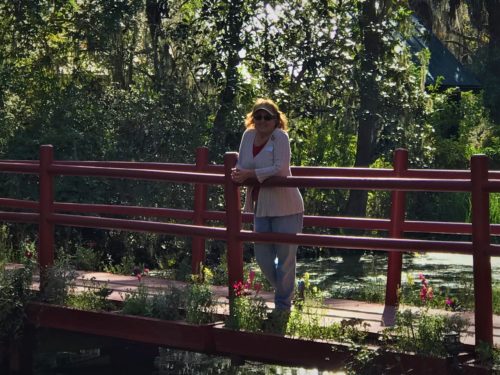



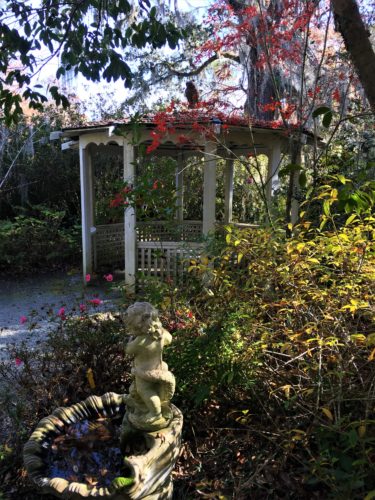



I think these are camellias




This is a view of the house from the garden trail.
After reading about it, we opted not to pay $16 to see the inside. We’ll get closer later.
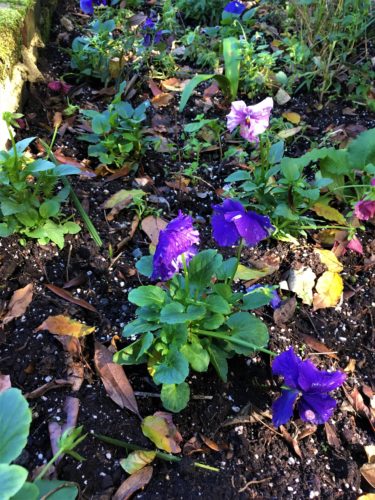
I know they’ve seen better days, but still, Pansies? Outside? In December??







Did you know that Spanish Moss is neither Spanish nor moss? Or that it doesn’t hurt the trees at all?

We discovered a Nature Trail sign and decided to check it out as a side trip. There was actually Critter Nature! And they didn’t elude us! Some even let us get really close before they sensed our repellent!
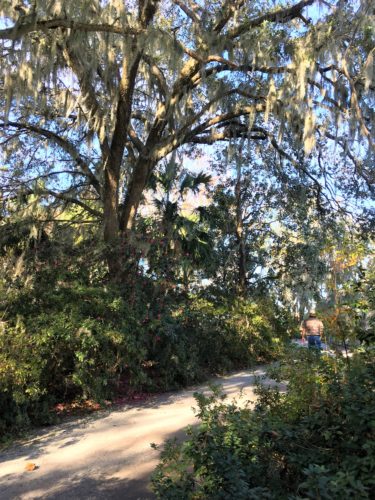

And this is not even zoomed in!
So beautiful!

Neither is this one.
He was across the path from the heron.


This guy was across the water, but made us wonder if any were right alongside the path.
We never saw any.




We didn’t know what this was. Some kind of heron or stork?





We found out later that the Plantation actually built these sunning platforms for the gators.
I don’t remember why, but I’m sure there was a reason.
The turtles seem to enjoy them as well!


The sign had said the trail was 1 1/2 miles, but it wasn’t on our map and we had no idea where it would take us. We were starting to get a tiny bit concerned because we had a deadline of 1:30pm for the tram ride. But then a man on a bicycle came by and told us we were close to returning to the gardens. We knew where we were from there.
Oh! Look! An Observation Tower! Check the time . . . Yep, we can do it! (Now we don’t have to come back to this part. : )


View from the top.
We thought we’d be able to see the house, but no.
We learned later that this was once all rice fields.


How nice to honor this man with a tower surveying part of the plantation.

The way back.

We came out near the house.
We learned later that this is actually the BACK of the house because visitors usually came by water.

Finding our way to the tram stop.

Focused on the wrong thing.
When I saw this “developed”, it struck me as a metaphor for life. How often are we focused on the future (ahead of us), rather than the here and now.


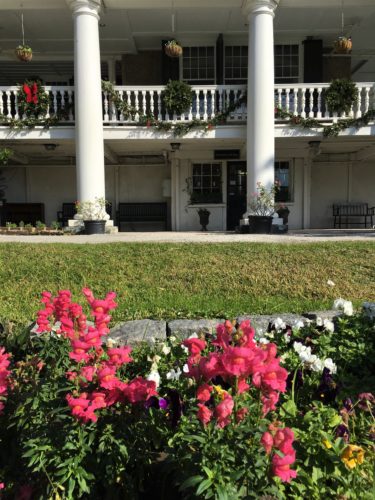
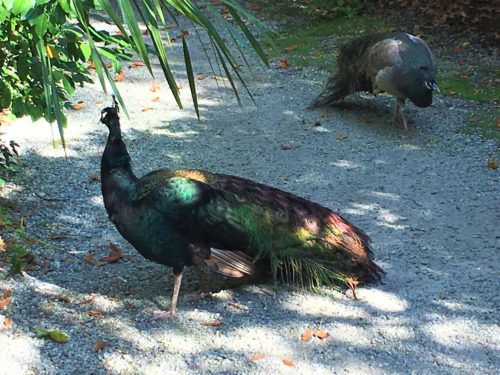
On the tram tour:


Migrating ducks that stop over. They were just arriving. Bet the gators are happy!


Unusual behavior.
Alligators eat turtles.
Guess this one’s not hungry. : )


This one was right next to the single lane road we were on.

Just look how close!
Our guide assured us that it’s crocodiles that attack people, not alligators. Unless someone has fed them.
Thanks, but I’ll not take my chances.

These were the slave quarters and for an additional $16, you could learn more.


This is the oldest tree on the plantation . . .
350 years!!!!!
I don’t know how they know that since they obviously can’t count the rings.
At any rate, the branches were far-spreading and very large!
It’s called a Live Oak.
We learned later that they’re called Live Oaks because they have leaves all year.



Still on the tram tour.
For an additional $16, we could have taken a Swamp Tour.
I’ve seen enough, haven’t you? : )

Here’s an interesting tidbit – this is an alligator trail.
To be more specific, it’s Bubba the Alligator’s trail. He’s the biggest one on the Plantation at 12′ and about 300 pounds!
He traverses the pond to the swampier area on a regular basis – right across the road.
By the way, this road is for bikes and pedestrians too. . . .
The tour finished, we looked in on the Conservatory. Not quite what we were expecting, but nice enough.

There were several tables set up in here for people to relax or meet.


I have no idea!
Anyone?
There were no identifiers in the Conservatory for any of the plants.

We’re heading back to the Garden Path now.


This is the front of the house. Strange how it’s not nearly as impressive.

This is a real, honest to goodness Civil War cannonball!
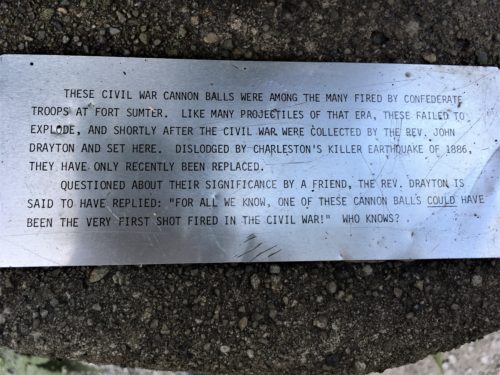
We didn’t get far. We came across a Museum. Free!

The Drayton Family Tree

South Carolina was the first to secede from the Union.

A rolltop or “Lambour” oak desk, circa 1900, made of quarter sawn oak, sometimes called “tiger oak” for the wood pattern it creates.
Believed to have been used by Mr. Norwood Hattie, a banker in Charleston.
I don’t know why it’s in the museum. They only had one other piece – a piano (coming up).

Take a look at that!
A penguin brought back by Admiral Byrd!


Here’s the letter the Admiral sent the family after they acquired the bird.
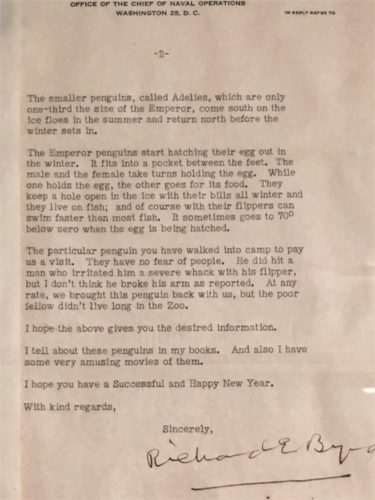




A close-up of one of the articles we thought was interesting.
Back on the Garden Path –
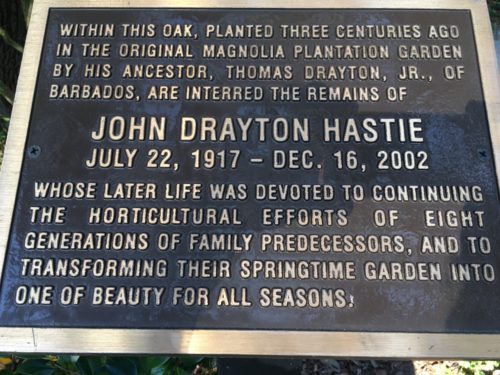
This is the guy that received the letter from Admiral Byrd.

Here’s the tree. We looked. We didn’t see any holes, so we’re not sure how they accomplished burying him IN the tree.



This is their “famous” bridge. In the Spring, there are an array of gorgeous flowers. You can see pictures on their website. It truly is beyond description.




We have no idea what this little building is.
There was no marker for it.

Bamboo! No pandas though. Darn!

Not sure why they felt they had to build the bridge around the tree.
What happens when the tree grows??
We walked around in their shrub maze, but just walking around the gardens themselves was a bit of a maze.






This tree was gigantic!
Back near the concession stand, they had miniature horses and a donkey. The horses weren’t friendly at all and the donkey was back in the corner. But the peacocks were there.




There’s a petting zoo where many of the animals are very friendly!


Blaine bought feed, but I don’t think we really needed it. : )
Some of the critters have names.

This is Abby.
She’s either very full or extremely lazy!

This is Gracie. What a sweetheart!

Winston
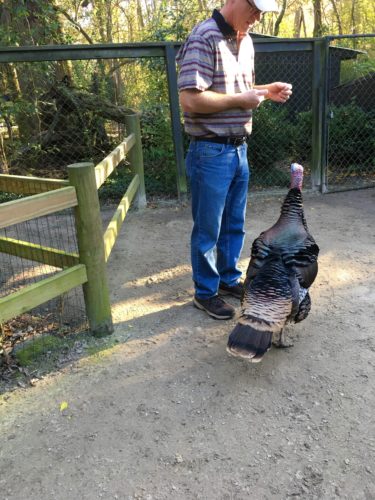

Garfield

Garfield followed us around everywhere. : )

PigPig


Skwirl








Sharing time’s a happy time!






And there are peacocks literally everywhere, both inside and outside the petting zoo area.

Outside the bathroom.
Now that was a bit of a surprise! : )

Outside the concession stand



Of course, there was a concession stand with “amusement park” prices . . . and peacocks for company. And an orientation video (which we watched at the end of the day. 😊 No peacocks here in the afternoon, but it was getting close to closing time . . . They probably clocked out for the day.)

Dinner was wood-fired pizza at Crust (cute name for a pizza place, huh?). It was really good!
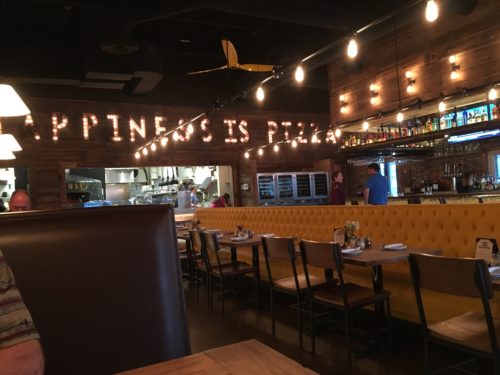
“Happiness is Pizza” in lights

This was their specialty pizza for tonight –
Sausage and peppers.
We substituted mushrooms for jalapenos and it was perfect!

“Carnivore”
It was good too!
But their take home boxes were unlike anything we’d ever seen before. We honestly didn’t think two pieces would fit, but they did, overlapping some. However, no sticking when we took them back out!
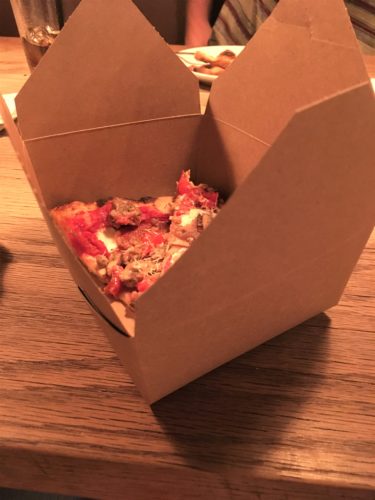
It’s always best to grocery shop on a full stomach, so we did that, too.
A big answer to prayer today, was learning that our oldest son landed a job with a new company! He’s very happy and so are we!
